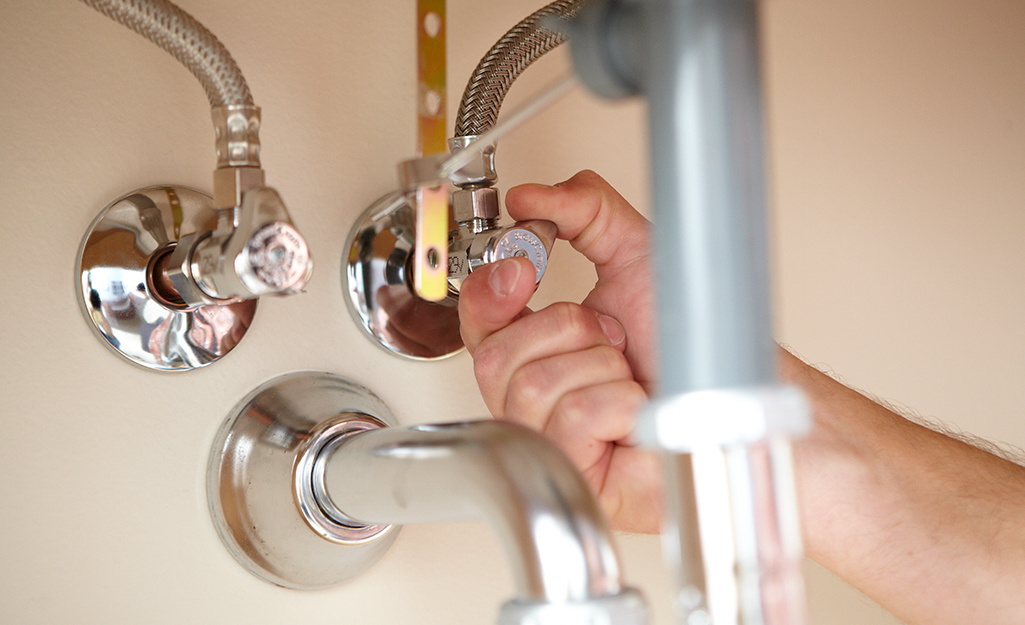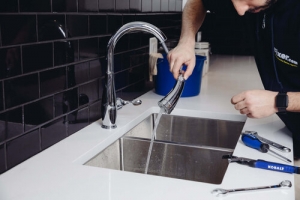Your Explanations Behind Fixing a Leaking Faucet
Your Explanations Behind Fixing a Leaking Faucet
Blog Article
We have discovered this great article relating to Water Dripping from Faucet: Why and How to Fix down the page on the internet and decided it made good sense to write about it with you on this page.

Leaking taps could appear like a small trouble, however their influence surpasses just the nuisance of the noise. From drainage to incurring unneeded monetary prices and health and wellness threats, disregarding a trickling faucet can cause various consequences. In this post, we'll explore why it's critical to address this usual household problem without delay and effectively.
Waste of Water
Ecological Effect
Trickling taps add considerably to water waste. According to the Epa (EPA), a single tap trickling at one drip per second can lose more than 3,000 gallons of water each year. This not just stress water sources however also affects communities and wild animals depending on them.
Financial Prices
Raised Water Expenses
Beyond the ecological effect, dripping faucets can blow up water expenses substantially. The gathered wastage with time translates right into greater utility expenditures, which could have been avoided with timely repairs.
Prospective Home Damages
Moreover, extended leaking can bring about damage to fixtures and surface areas surrounding the faucet. Water accumulation can cause discoloration, deterioration, and also architectural issues if left neglected, resulting in added repair service costs.
Wellness Worries
Mold And Mildew and Mildew Development
The continuous presence of wetness from a dripping tap creates an optimal atmosphere for mold and mildew and mildew development. These fungi not only endanger indoor air top quality however additionally position health dangers, especially for individuals with respiratory system conditions or allergic reactions.
Waterborne Diseases
Stagnant water in leaking taps can end up being a breeding place for germs and various other pathogens, boosting the risk of waterborne illness. Impurities such as Legionella bacteria grow in stagnant water, potentially bring about significant illnesses when ingested or inhaled.
DIY vs. Expert Fixing
Advantages and disadvantages of Do It Yourself Fixing
While some might try to deal with a trickling faucet themselves, DIY repairs come with their very own collection of difficulties. Without appropriate understanding and tools, DIY efforts can aggravate the problem or result in insufficient fixings, extending the trouble.
Advantages of Working With a Specialist Plumber
Employing a specialist plumber makes sure that the underlying root cause of the trickling tap is attended to properly. Plumbing professionals possess the proficiency and tools to diagnose and fix tap issues effectively, conserving time and minimizing the danger of more damage.
Step-by-Step Guide to Taking Care Of a Dripping Tap
Devices Required
Before attempting to repair a trickling faucet, gather the required tools, including an adjustable wrench, screwdrivers, replacement parts (such as washers or cartridges), and plumber's tape.
Common Tap Issues and Their Solutions
Identify the sort of tap and the details problem triggering the drip. Typical problems include worn-out washers, corroded valve seats, or faulty O-rings. Refer to producer instructions or on-line tutorials for step-by-step advice on repair services.
Preventive Measures
Regular Upkeep Tips
To stop leaking taps, carry out routine maintenance such as cleaning aerators, examining for leaks, and changing worn-out parts immediately. Additionally, consider setting up water-saving tools or updating to much more reliable components.
Relevance of Prompt Repairs
Attending to leaking taps as soon as they're observed stops more water wastefulness and possible damage, ultimately conserving both water and cash over time.
Effect On Property Worth
Understanding of Well-Maintained Residential Property
Preserving a residential property in good condition, consisting of resolving maintenance concerns like dripping taps, improves its viewed worth and value amongst prospective buyers or occupants.
Impact on Resale Value
Qualities with properly maintained plumbing fixtures, consisting of taps, command higher resale worths in the realty market. Dealing with dripping taps can contribute to a positive perception during building assessments and negotiations.
Ecological Responsibility
Specific Payment to Conservation
Taking obligation for taking care of trickling taps straightens with wider initiatives toward water conservation and ecological sustainability. Every individual's actions jointly make a considerable impact on maintaining valuable resources.
Sustainable Living Practices
By focusing on timely repairs and embracing water-saving behaviors, individuals contribute to lasting living techniques that profit both existing and future generations.
Verdict
Attending to a dripping faucet goes beyond mere ease; it's a crucial step towards preserving water, minimizing economic costs, and guarding health and wellness and residential property. Whether through DIY repairs or expert support, doing something about it to deal with trickling faucets is a little yet impactful method to advertise accountable stewardship of resources and contribute to a much healthier, a lot more sustainable future.
How to Fix a Leaky Faucet: Step-by-Step Repair Guide
A leaky faucet may seem like a simple annoyance, but if it's not fixed promptly, that leak could cost hundreds to potentially thousands. From water damage to mold, mildew, and high water bills, even a tiny leak can be catastrophic if left unattended. Damage like this can even affect the overall value of your home, so it's important to take the right approach for leaky faucet repair. You may need the help of a plumber in some cases, but we've got a few tips you can try on how to fix a leaky faucet before calling the pros.
Four Faucet Types
When you're learning how to fix a leaky faucet, the first step is knowing what kind of faucet you're working with! There are four common types.
Cartridge Faucets
Cartridge faucets come in one- or two-handled varieties. In one-handled cartridge faucets, hot and cold water combines in a single cartridge. In the two-handled versions, hot and cold water are controlled separately and mixed in the faucet.
Ball Faucets
Ball faucets have a single lever you push up and down to adjust the pressure and rotate to change the temperature. A slotted metal ball controls the amount of water allowed into the spout.
Compression Washer Faucets
They're the oldest type of faucet, but they're still used in many homes — especially older ones. Compression faucets have two separate handles that, when turned, raise or lower the washer that seals a water valve. This valve stops water from flowing through the faucet when it is turned off.
Disc Faucets
Disc faucets rarely need to be repaired due to their maintenance-free design. The water flow is controlled by two discs — the upper one raises and lowers against a fixed lower disc, creating a watertight seal. If your disc faucet starts leaking, you may need to replace the seals or clean residue buildup from the inlets.
Fixing a Leaky Faucet
Step 1: Turn Off the Water
Whether you're learning how to fix a leaky bathtub faucet or how to fix a leaky kitchen faucet, always turn off the water supply to your working area when you're fixing a leak. The last thing you want is a flood added to your list of things to fix.
Look for the shutoff valves below your sink or around the tub and turn them clockwise to stop the water flow. If your faucet doesn't have shutoff valves, you may need to turn off the water for the whole house. Check to make sure it's off by turning the faucet on. If nothing comes out, you're ready to start the repair.
Step 2: Take Apart the Faucet
How you disassemble your faucet depends on the type of fixture you have. You can use a flathead screwdriver to remove the caps on top of the handle or handles for cartridge and compression faucets. Inside, you should see handle screws. Unscrew these with a screwdriver to remove the handle.
Disc- and ball-style faucets will typically have an inlet screw near the handle, and removing that will reveal the interior of the faucet.
Detach the Valve Stem
For cartridge- and compression-style faucets, you'll see the inner valve stem or cartridge once you remove the faucet handles. If you have a compression faucet, unscrew the brass valve stem. If you have a cartridge faucet, pull out the cartridge. If your cartridge has been in place for a while, it may require some tools or extra force to remove it due to mineral deposits.
Examine and Replace Parts
Once you've removed the parts, check them out to confirm what needs to be replaced. You may see corroded rubber washers, O-rings, stems, or cartridges. On a ball-style faucet, check the seats and springs for damage.
If you need to repair a leaky disc faucet, check the inlet and seals on the lower disc.
Once you determine what parts must be replaced, visit your local hardware store. Bring the damaged parts with you to ensure you can purchase the correct components to replace them.
Clean Valves and Faucet Cavity
If you've removed a stem or cartridge, you may notice mineral buildup in the faucet's threads. Use white vinegar to clean the valve seat by soaking it for a few minutes, then scrub it away with a soft toothbrush and rinse with warm water. You can also clean the interior of the faucet in the same way.
Reassemble the Faucet
Once your faucet is cleaned and the required parts have been replaced, it's time to reassemble it. Put the pieces back together and slowly turn the water supply back on. Doing this slowly is crucial because too much initial water pressure can damage the new hardware you've just installed.
https://homewarranty.firstam.com/blog/how-to-fix-leaky-faucet

We are very occupied with Why Are My Faucets Dripping (And Can I Fix It Myself)? and I hope you appreciated the post. Are you aware of someone else who is serious about the subject? Please feel free to promote it. Thank you so much for taking the time to read it.
Report this page